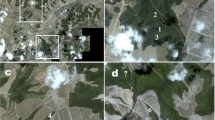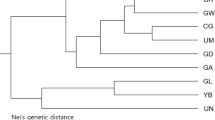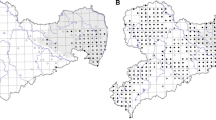Abstract
We analyzed genetic differentiation of Rosa rubiginosa by RAPD from populations growing in two Argentinean ecoregions, Chaco Serrano and Patagonian Steppe. Leaf material was collected during the spring and summer of 2006. UPGMA dendrogram and PCoA clearly suggest a geographical differentiation of the provenances of R. rubiginosa populations. AMOVA analyses revealed high genetic variation within populations (71%) and low variation between populations (29%), in agreement with values estimated by the Shannon–Weaver index. Genetic differentiation between populations estimated by AMOVA was ϕPT = 0.29 (P < 0.001). Nei’s Gst (0.2205) was lower for interpopulation variation. The low interpopulation value obtained suggests genetic homogeneity between the populations. The presence of specific monomorphic bands accounts for the genetic differentiation between populations. The high percentage of within-population genetic diversity suggests the introduction of genetic variation into both ecoregions. From the present results we can conclude that we observed two independently established populations with high similarity between them and a strong intrapopulation differentiation. The empty niche hypothesis for explainging invasion success might explain the invasiveness of R. rubiginosa in Argentinean ecoregions.




Similar content being viewed by others
References
Aguirre GU, Ciuffo GM, Ciuffo LEC (2007) Producto forestal no maderero. Rosa rubiginosa (L.), exótica de interés medicinal y vomercial. BLACPMA 6(5):230–231
Allnutt TR, Newton AC, Premoli A, Lara A (2003) Genetic variation in the threatened South American conifer Pilgerodendron uviferum (Cupressaceae), detected using RAPD markers. Biol Conserv 114:245–253
Bossdorf O, Auge H, Lafuma L, Rogers WE, Siemann E, Prati D (2005) Phenotypic and genetic differentiation between native and introduced plant populations. Oecologia 144:1–11. doi 10.1007/s00442-005-0070-z
Bran D, Damascos M, Lopéz C, Ayesa J, Umaña F, Moraga H (2003) Distribución, abundancia y disponibilidad de frutos de rosa mosqueta en la Provincia de Neuquén. Comunicación Técnica de Relevamiento Integrado no. 85. Instituto Nacional de Tecnologia Agropecuaria, Buenos Aires
Bran D, Damascos M, Lopéz C, Ayesa J, Umaña F, Moraga H (2004) Distribución, abundancia y disponibilidad de frutos de rosa mosqueta en la Provincia de Neuquén. Patagonia For 10(1):6–8
Brown AHD, Marshall DR (1981) Evolutionary changes accompanying colonization in plants. In: Scudder GGE, Reveal JL (eds) Evolution today. Carnegie-Mellon University, Pittsburg, pp 351–363
Chandrasekharan C, Frisk T, Campos RJ (1996) Desarrollo de productos forestales no madereros en América Latina y el Caribe. FAO, Santiago, Chile
Damascos MA, Bran D (2006) Rosa canina (Rosaceae) a new record for the Argentinian flora. Hickenia 3(63):285–288
Damascos MA, Gallopin G (1992) Ecología de un arbusto introducido, Rosa rubiginosa L. = Rosa eglanteria L.: riesgo de invasión y efectos en las comunidades vegetales de la región andino-patagónica de Argentina. Rev Chil Hist Nat 65:395–405
Davis MA, Thompson K, Grime JP (2005) Invasibility: the local mechanism driving community assembly and species diversity. Ecography 28:5
Doyle JJ, Doyle JL (1987) A rapid DNA isolation procedure for small quantities of fresh leaf tissue. Phytochem Bull 19:11–15
Ellstrand NC, Schierenbeck KA (2000) Hybridization as a stimulus for the evolution of invasiveness in plants? Proc Natl Acad Sci USA 97:7043–7050
Gauer L, Cavalli-Molina S (1999) Genetic variation in natural populations of maté (Ilex paraguariensis A. St.-Hil., Aquifoliaceae) using RAPD markers. Heredity 84:647–656
Gilpin M (1994) Community-level competition—asymmetrical dominance. Proc Natl Acad Sci USA 91:3252–3254
Hierro JL, Maron JL, Callaway RM (2005) A biogeographical approach to plant invasions: the importance of studying exotics in their introduced and native range. J Ecol 93:5–15
Holm S (1995) Unexpectedly high levels of genetic variation in Potentilla argentea L. (s. L.) in southern Sweden. Hereditas 123:127–139
Huff DR, Peakall R, Smouse PE (1993) RAPD variation within and among natural populations of outcrossing buffalograss [Buchloe dactyloides (Nutt) Engelm.]. Theor Appl Genet 86:927–934
Jaccard P (1908) Nouvelles recherches sur la distribution florale. Bull Soc Vaud Sci Nat 44:223–270
Jordano P, Godoy JA (2000) RAPD variation and population genetic structure in Prunus mahaleb (Rosaceae), an animal-dispersed tree. Mol Ecol 9:1293–1305
Jürgens AH, Seitz B, Kowarik I (2007) Genetic differentiation of Rosa canina (L.) at regional and continental scales. Plant Syst Evol 269:39–53
Khanuja SPS, Shasany AK, Darokar MP, Kumar S (1999) Rapid isolation of DNA from dry and fresh samples of plants producing large amounts of secondary metabolites and essential oils. Plant Mol Biol Rep 17:1–7
Ladio AH (2005) Malezas exóticas comestibles y medicinales utilizadas en poblaciones del Noroeste patagónico: aspectos etnobotánicos y ecológicos. BLACPMA 4(4):11–17
Ladio AH, Lozada M (2001) Non-timber forest product use in two human populations from NW Patagonia: a quantitative approach. Hum Ecol 29(4):367–380
Ladio AH, Rapoport EH (2002) La variación estacional de las plantas silvestres comestibles en baldios suburbanos de Bariloche, Parque Nacional Nahuel Huapi, Patagonia, Argentina. Vida Silv Neotrop 11:33–41
Ladio AH, Lozada M, Weigandt M (2007) Comparison of traditional wild plants use between two Mapuche communities inhabiting arid and forest environments in Patagonia, Argentina. J Arid Environ 69:695–715
Manzur MJ, Muñoz RV, Lucero AA, Juri Ayub M, Alvarez SE, Ciuffo GM (2006) Production of recombinant enzymes of wide use for research. Electron J Biotechnol 9:291–296
Martín JP, Hernandez Bermejo E (2000) Genetic variation in the endemic and endangered Rosmarinus tormentosus Huber-Morath & Maire (Labiatae) using RAPD markers. Heredity 85:434–443
Millan T, Osuna F, Cobos S, Torres AM, Cubero JI (1996) Using RAPDs to study phylogenetic relationships in Rosa. Theor Appl Genet 92:273–277
Monteleone I, Ferrazzini D, Belletti P (2006) Effectiveness of neutral RAPD markers to detect genetic divergence between the subspecies uncinata and mugo of Pinus mugo Turra. Silva Fenn 40(3):391–406
Moore JL, Mouquet N, Lawton JH, Loreau M (2001) Coexistence, saturation, and invasion resistance in simulated plant assemblages. Oikos 94:303–314
Morton RD, Law R, Pimm SL, Drake JA (1996) On models for assembling ecological communities. Oikos 75:493–499
Moure A, Franco D, Sineiro J, Domínguez H, Núñez MJ, Lema JM (2001) Antioxidant activity of extracts from Geuvina avellana and Rosa rubiginosa defatted seeds. Food Res Intern 34:103–109
Nei M (1972) Genetic distance between populations. Am Nat 106:283–292
Nei M (1973) Analysis of gene frequences in subdivided populations. Proc Natl Acad Sci USA 70:3321–3323
Nybom H (2004) Comparison of different nuclear DNA markers for estimating intraspecific genetic diversity in plants. Mol Ecol 13:1143–1155
Nybom H (2006) Genetic diversity in recently domesticated fruit and berry crops. In: NJF seminar no. 391: fruit and Berries: new crops and new uses. Nordic Association of Agricultural Scientists, Kristianstad, Sweden, 18-20 September 2006
Nybom H, Bartish I, Garkava-Gustavsson L, Persson H, Werlemark G, Esselink D (2003) Evaluating genetic resources in minor fruits. Acta Hort (ISHS) 622:81–94
Olsson A, Nybom H, Prentice HC (2000) Relationships between Nordic dogroses (Rosa L. sect. Caninae, Rosaceae) assessed by RAPDs and elliptic Fourier analysis of leaflet shape. Syst Bot 25(3):511–521
Peakall R, Smouse PE (2006) GENALEX 6: genetic analysis in Excel. Population genetic software for teaching and research. Mol Ecol Notes 6:288–295
Petit RJ (2004) Biological invasions at the gene level. Divers Distrib 10:159–165
Rohlf FJ (1997) NTSYSpc v. 2.01.e. Numerical taxonomy and multivariate analysis system. Exeter, New York
Shannon CE, Weaver W (1949) The mathematical theory of communication. University of Illinois Press, Urbana
Tacón AC, Palma JM, Fernández U, Ortega FB (2006) El mercado de los productos forestales no madereros y la conservación de los bosques del sur de Chile y Argentina. WWF Chile, Valdivia, Chile
Valladares J, Palma M, Sandoval C, Caravajal F (1986) Crema de aceite de mosqueta (Rosa aff. rubiginosa L.) II. Parte: estudio de las propiedades físico-químicas de estabilidad, eficacia, cosmética y aplicación sistemática en clínica. Anal Real Acad Farm 51:597–612
Vavra M, Parks CG, Wisdom MJ (2007) Biodiversity, exotic plant species, and herbivory: the good, the bad, and the ungulate. For Ecol Manage 246:66–72
Werlemark G (2000) Evidence of apomixis in hemisexual dogroses, Rosa section Caninae. Sex Plant Reprod 12:353–359
Werlemark G, Nybom H (2001) Skewed distribution of morphological character scores and molecular markers in three interspecific crosses in Rosa section Caninae. Hereditas 134:1–13
Werlemark G, Uggla M, Nybom H (1999) Morphological and RAPD markers show a highly skewed distribution in a pair of reciprocal crosses between hemisexual dogrose species, Rosa sect. Caninae. Theor Appl Genet 98:557–563
Williams JGK, Kubelik AR, Livak KJ, Rafalski JA, Tingey SV (1990) DNA polymorphisms amplified by arbitrary primers are useful as genetic markers. Nucleic Acids Res 18:6531–6535
Yeh FC, Yang RC, Boyle TBJ, Ye ZH, Mao JX (1997) POPGENE, the user-friendly shareware for population genetic analysis. Molecular Biology and Biotechnology Centre, University of Alberta, Alberta, Canada
Author information
Authors and Affiliations
Corresponding author
Rights and permissions
About this article
Cite this article
Aguirre, G.U., Ciuffo, G.M. & Ciuffo, L.E.C. Genetic differentiation of Rosa rubiginosa L. in two different Argentinean ecoregions. Plant Syst Evol 281, 183–192 (2009). https://doi.org/10.1007/s00606-009-0200-x
Received:
Accepted:
Published:
Issue Date:
DOI: https://doi.org/10.1007/s00606-009-0200-x




